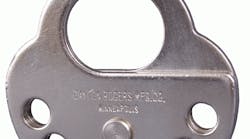This file type includes high resolution graphics and schematics when applicapable.
Many people view safety standards as a pain in the neck and that conforming to them is a cost without a benefit. The reality, however, is that lockout and tagout safety standards increase productivity while promoting safety. And in any operation, enhanced safety, more uptime, and higher production quickly adds to the bottom line.
Single-point lockout (SPLO) is a case in point, as it is a way to reduce the number of lockout locations on machinery. Following applicable standards and incorporating SPLO creates real savings and benefits.
American National Standards Institute/American Society of Safety Engineers (ANSI/ASSE) Z2244.1-2003 (R2008), “Control of Hazardous Energy Lockout/tagout Alternative Methods,” reduces the time required for safety procedures while increasing the degree of safety.
ANSI/Packaging Machinery Institute (PMMI) B155.1-2011, “Safety Requirements for Packaging Machinery and Packaging-Related Converting Machinery” covers safety shutoff and exhaust valves. It requires such valves to be:
• Lockable in the OFF (closed) position only.
• Easy to operate (for example, a simple pull/push action for pneumatics).
• Equipped with an exhaust port sized to vent pressure in an acceptable period of time as determined by the risk assessment.
• Equipped with a pressure indicator (such as a gauge) visible to the operator to indicate that the line is relieved of pressure.
SLPO reduces the chance that an operator might miss or skip locking out an energy source when rushing to lock out a machine and begin work such as setup, adjustment, or repair. So, it provides better assurance that lockouts will be properly used, in turn increasing operator and equipment protection. In addition, SPLO reduces the time required to put the machine into a safe mode, as well as the time required to bring the machine back into service once the issue is resolved.
This file type includes high resolution graphics and schematics when applicapable.
Safety In Action
When workers must clear a jam to gain access to a machine’s hazardous area, all energy sources must be locked out. This requires time to stop the machine and apply lockout to a number of devices that might not be located together.
Getting the machine up and running again first requires operators or maintenance technicians to verify that all sources of energy have been turned off or removed through lockouts. Then they must clear the jam, remove the lockouts and, finally, restart the machine.
This is a time-consuming and labor-intensive process, and it can create opportunities for workers to miss an energy-source lockout. Workers also could bypass the energy-source lockout if they think the procedure takes too long or if they erroneously believe that simply removing electrical power is enough to put the machine into a safe mode.
To overcome these issues, one consumer-products company put lockout/tagout standards to work with a double valve from Ross Controls to reduce lockout time and save money (Fig. 1). The safety valves provide a self-contained monitoring system with flexibility for applications in which only pneumatic hazards exist. The company also can easily integrate the same pneumatic safety hardware in more complicated safety applications.
The Ross DM Series valves were used in both remote lockout systems as well as alternate hazardous-energy control circuits, and they have proven to be reliable and cost effective in many of the manufacturer’s commercial applications, according to the company’s senior safety engineer. It also lets the company build a complete pneumatic safety system into its production equipment.
In practice, the company reduced lockout time by more than 4 min on a machine that averages eight jams per shift. The result was 32 min more uptime per shift, or 1 hr and 36 min/day. That adds up to a full 8-hr shift of additional production time over five days.
Manufacturers often use electrical safety systems to stop equipment by installing interlocks on doors or simply hitting the E-stop button. Using a single lockout point that is required to gain access helps ensure that all energy sources are accounted for and the machine is in a safe state.
Placing this lockout at a convenient and typical entry point on a large piece of machinery quickly allows for safe operator access. This eliminates the time that otherwise would be needed to work one’s way in and around a machine to find and disable multiple lockouts (Fig. 2). SPLO offers safety and productivity in a single package, and manufacturers can calculate the return on investment based on the lockout time savings.
In some situations, a false perception can exist that air has been quickly and completely dissipated. This can occur when a shutoff and exhaust valve is closed. The operator may be unaware that the valve has a small bleed vent for an exhaust port. This is the case for most ball valves used in common packaging applications.
Requiring a full exhaust port helps avoid the situation. For example, when exhausting one cubic foot of 100-psig compressed air, a fully ported 1-in. valve will dump the air in 1.2 sec. In contrast, a 1-in. ball valve with a vented exhaust takes 4 min to complete the task.
An operator might not realize it takes so long to exhaust the system and could unknowingly access the machine before the air is fully exhausted. Using a valve with a full-size exhaust port reduces the risk that the operator will begin servicing the machine before air pressure has fully dissipated.
DAN HENMAN is vice president of Ross Controls, an international manufacturer of pneumatic valves, controls systems, and safety products for the fluid-power industry based in Troy, Mich.




